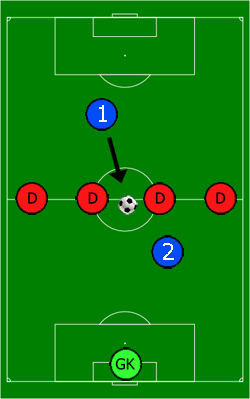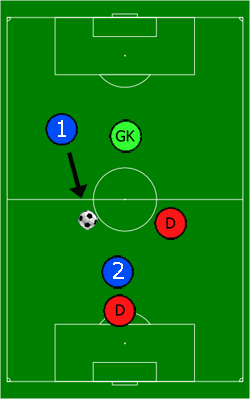
Why do we even have a soccer offside rule?
Without the soccer offside rule, the game would be a whole lot more chaotic and a lot less tactical, at least that's the theory behind it. The rule prevents attacking players from camping out behind the defensive line waiting for long balls to be played to them. This type of strategy would take little skill, would be difficult to defend against, and would prevent the defence from actively participating in the play. The offside rule also gives the defence one more way to prevent attacking teams from scoring, as many teams use an active offside trap to keep strikers away. Unfortunately, many in soccer dislike this rule, as it does reduce scoring. In fact, throughout the years the rule has been altered to increase offense and scoring.
Offside, according to the rules....
 The FIFA Laws of the Game state that to be offside, you must be:
The FIFA Laws of the Game state that to be offside, you must be:- In an offside position
- Involved in active play
Let's take a look at what both of these mean.
The Offside Position
To be in an offside position, you have to be closer to the goal line than both the ball and the second-to-last opponent when the pass or play is made. As you can see in the first figure, player number 2 is in a soccer offside position because he is closer to the goal line than the second to last player on the red team.
 Some things to keep in mind here: Some things to keep in mind here:
- While the second-to last opponent usually means the goal keeper and an outfield player, this isn't always the case. Figure 2 is slightly unusual as the goalkeeper for the red team has moved up-field, which some may find confusing as the the keeper is usually considered the last player. Once again though, the player is closer to the goal line than the second to last player, and is in an offside position. As soon as he becomes active in the play will have comitted the offside infraction.
- The rule was changed in changed in 1990 to allow players to be level with the second-to-last opponent. This means you can stand in line with your opponent while awaiting a pass.
- Linesmen will generally stand in line with the second-to-last opponent and judge anyone between themselves and the goal line as in an offside position.
Involved in Active Play
This is where the rule can start to get a little more complicated.You have to be involved in the active play before an offside offense can be called. Usually this means the ball has to be played to you but can also mean that you block the opponent or gain advantage from the play. For example, if you're standing alone next to the opposing goalie and a shot on net is made by a teammate, you are not offside because you were not involved in the active play. Now let's say the ball rebounds, either off the goalie or the post, and comes to you. According to the rules, you gained an advantage from being in that offside position and you have now committed the offence.
Keep in mind....
- There are no soccer offsides off of corner kicks, goal kicks, or throw-ins
- You can only be offside in your opponents half of the field.
- You can be offside for the entire game as long as you're not involved in the active play...of course you're not being of much use to your team if you are!
- Seems obvious, but you cannot place yourself offside. That is to say if you kick a ball from in front of the defence and chase after it, it's impossible to be offside.
Return from Soccer Offside to Soccer Rules
|











